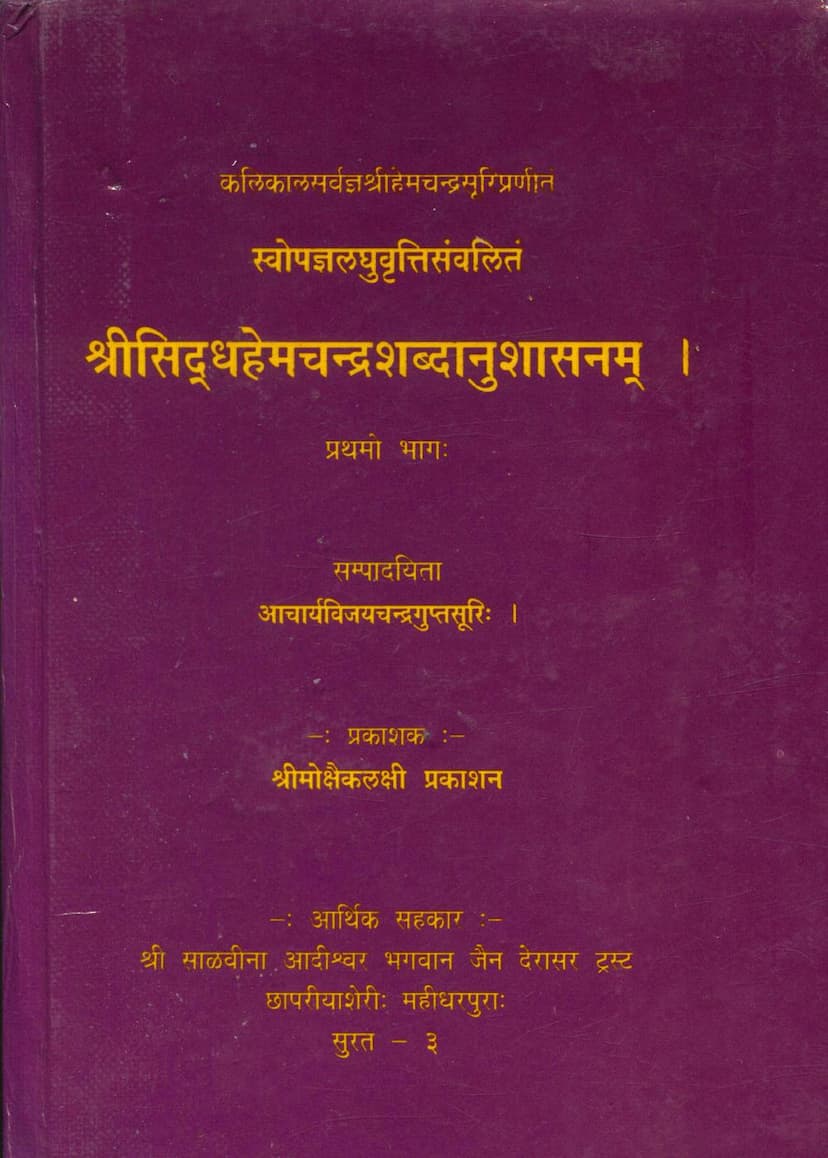Siddhhemchandra Shabdanushasanam Part 01
Added to library: September 2, 2025

Summary
This is a summary of the Siddhahemchandra Shabdanushasanam, Part 01, authored by Chandraguptasuri (as the editor/compiler) and based on the original work of Hemchandracharya. The publisher is Mokshaiklakshi Prakashan.
The text appears to be a comprehensive grammar of the Sanskrit language, following the principles of Jain scholars and particularly focusing on the teachings of Hemchandracharya.
Here's a breakdown of the content based on the provided pages:
Core Information and Introduction:
- Title: Shri Siddhhemchandra Shabdanushasanam, Part 01.
- Author/Editor: Acharya Vijayachandra Gupta Suri is credited as the editor (Sampadita).
- Original Author: The work is based on the Shabdanushasanam composed by Kalikalsarvajna Shri Hemchandrasuri.
- Publisher: Shri Mokshaiklakshi Prakashan.
- Financial Support: Provided by Shri Salvina Aadieshwar Bhagwan Jain Derasar Trust, Chapriya Sheri, Mahidharpura, Surat.
- Invocation: Begins with "Om Arh Namah," a salutation to the divine.
- Purpose: The title itself suggests it's a guide to Shabda (words/grammar), aiming for Siddhi (perfection/accomplishment), likely rooted in Syadvada and Anekantavada (Jain philosophical principles).
- Methodology: The grammar will derive principles from the established linguistic traditions (lokat) and the alphabetical tradition (varnasamāmnāya).
Key Grammatical Concepts Introduced (Pages 8-18):
The initial pages lay the groundwork for Sanskrit grammar by defining fundamental elements:
-
Vowels (Svara):
- Defined as sounds ending in 'au' (औ).
- Includes A (अ), Ā (आ), I (इ), Ī (ई), U (उ), Ū (ऊ), Ṛ (ऋ), ṚḶ (ॠ), LḶ (लृ), LḶ (लॄ), E (ए), AI (ऐ), O (ओ), AU (औ).
- Matra: Defines measure of time for pronunciation: one, two, or three measures for hrasva (short), dīrgha (long), and pluta (prolated) sounds. Examples: a, i, u, ṛḷ (short); ā, ī, ū, ṛ, l (long); e, ai, o, au, ā3, ī3, ū3 etc. (pluta).
- Nāmi: Defines vowels excluding 'a' (अ) as nāmi (nominal sounds).
- Samāna: Defines vowels up to 'lū' (लॄ) as samāna (similar/connected).
- Sandhyakshara: Defines E (ए), AI (ऐ), O (ओ), AU (औ) as diphthongs.
- Anusvāra and Visarga: Defines 'am' (अं) as nasal and 'aḥ' (अः) as guttural, designated as anusvāra and visarga respectively.
-
Consonants (Vyanjana):
- Defined as sounds from 'ka' (क) to 'ha' (ह).
- Lists the consonants: k, kh, g, gh, ṅ; c, ch, j, jh, ñ; ṭ, ṭh, ḍ, ḍh, ṇ; t, th, d, dh, n; p, ph, b, bh, m; y, r, l, v; ś, ṣ, s, h.
- Dhuṭ: Defines consonants excluding the fifth letter of each class (pañca).
- Varga: Defines groups of five consonants (e.g., k, kh, g, gh, ṅ).
- Aghoṣa: Defines the first two consonants of each class plus ś, ṣ, s as voiceless/unvoiced (aghoṣa).
- Ghoṣavān: Defines the remaining consonants of each class plus y, r, l, v, h as voiced (ghoṣavān).
- Antastha: Defines y, r, l, v as medial consonants.
- Śiṭ: Defines 'am', 'a', 'k', 'p', 'ś', 'ṣ', 's' with specific visual/phonetic descriptions.
- Svaḥ (Vowel Sound): Defines a vowel sound as having identical place of articulation (sthāna) and effort of articulation (āsya-prayatna). It elaborates on the eighteen variations of 'a' (vowels generally have variations based on tone like udātta, anudātta, svarita, nasalization, length, etc.) and their places of articulation.
-
Suffixes (Pratyaya) and Word Formation (Pada):
- Introduces suffixes like syādayaḥ (starting with syā - 'may be'), jas, śas, ti, bhis, ḍe, ṅasi, ṅaso, ām, os, supāṃ.
- Defines pada (word) as ending with these suffixes.
- Rules for forming words (e.g., nāma siddha vyanchane, naṁ kyē, naṁ staṁ matvarthe, manuḥ nabho'ṅgiro vati).
- Explains avakhyātam (sentence) as containing specific verbs and qualifiers.
- Defines adhātu-vibhāti-vākyamarthavatrāma (a meaningful word form not ending in a verb or suffix).
-
Indeclinables (Avyaya):
- Defines svarādayo avyayam (vowels and others like antar, prātar are indeclinables).
- Explains rules for achādayo asattve (cha and others in the absence of a noun).
- Rules for forming indeclinables from suffixes like śas.
Structure and Scope:
The text is structured into chapters and sections, indicated by the pāda (quarter/section) and sūtra (rule) numbering. It systematically covers the phonetic elements, word formation, case endings, verb conjugations, and other grammatical phenomena of Sanskrit. The detailed sūtras suggest a thorough and systematic approach to grammar.
Overall Impression:
The provided pages indicate a scholarly and detailed exposition of Sanskrit grammar, likely intended for students and scholars of linguistics, particularly within the Jain tradition. The emphasis on Hemchandracharya suggests a connection to his influential grammatical work, Siddhahemchandra Shabdanushasanam, a monumental text in Sanskrit grammar. The text is meticulously organized, defining terms and rules with precision.